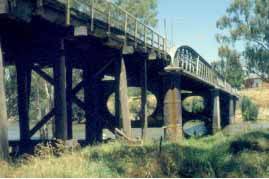| Back to search results » | Back to search page » |
|
John Foord Bridge over the Murray River
Other NameVic Roads Country Directory MapVSD 34 H2 LocationFoord Street,, WAHGUNYAH VIC 3687 - Property No B7296
File NumberB7296LevelState |
|
Statement of Significance
What is significant? The John Foord Bridge is a steel truss and timber girder road bridge of 11 spans comprising riveted steel main spans across the Murray River and timber approach spans. It is located between the Towns of Corowa and Wahgunyah and forms one of a small number of important connections between Victoria and the New South Wales Riverina. It was built in 1892 by the New South Wales Roads Department to a design of J. A. McDonald.
How is it significant? The John Foord Bridge is significant for aesthetic/architectural, historic, scientific (technical) and social reasons at a State level. It is also of National significance for its association with the history of Federation.
Why is it significant? The John Foord Bridge has historical significance for over 100 years as an important link over the Murray River. It was erected at a time of high commercial activity in the town of Corowa, although river traffic was declining with the coming of the railway.
The bridge is rare as one of a small number of surviving iron lattice bridges, which was an imported British Bridge technology that was still dominant at this time and formed the dominant group of major metal road bridges in the 1860s to 1890s (18 in New South Wales, 10 in Victoria). At the time of completion 1892, it was one of only four bridges over the Murray River (Albury, Corowa, Mulwala and Echuca) and therefore it had a significant impact on inter-colonial commerce and communication.
The bridge is of also of historical significance for its association with the prominent local identity and pioneer businessman John Foord, who was involved in the company that erected the 1862 timber bridge on the site. When the new bridge was built as a replacement, it took the same name.
The bridge is also associated with John A McDonald, its designer, who was the leading bridge engineer in the New South Wales Public Works Department at the time, and whose design for timber truss road bridges in 1884, now bears his name.
The John Foord Bridge is also important for its association with Federation, having been built in the atmosphere of colonial co-operation that was developing in the late nineteenth century and it was a feature of the Federation Conference in Corowa in July 1893, becoming a symbol of the unification of the colonies. When opened in January 1893, traffic was still impeded by customs delays, resulting in strong and persistent advocacy of federation from the locals. The bridge is significant as a symbol of Federation, having been built at the time of the major debates and conferences leading up to Federation and situated in a town in which the main Federation conference was held and which was subsequently the site of cross-border celebrations when Federation was announced. The surviving customs houses provide a strong physical and symbolic representation of the site role in the Federation movement. It is of technical significance as a rare example of an iron lattice road bridge, being the only one of its type in the group of road bridges over the Murray River between Albury and the South Australian border.
The shallow depth of the truss was achieved by continuity of the structure across the piers. This helped McDonald to achieve spans of 34.2, 42.7, and 34.2 metres. The central span is the 6th longest span of a metal road bridge in Victoria, and the 14th longest bridge span bridge of any type recorded in the National Trust bridges database.
The John Foord Bridge is of aesthetic or architectural significance for its outstanding setting and landmark qualities, and its distinctive size and appearance and notably the unusual curved ends of the trusses, the length of the combination of the three lattice truss spans, and the long timber approach span section.
The bridge provides a gateway to NSW and the town of Corowa. With the open land on the Corowa Bank and the colonial buildings on the high Wahgunyah side the bridge forms a heritage environment that is remarkably intact to the period of construction. The John Foord Bridge has high social significance as a local landmark and identified heritage and tourism feature in the region. The bridge was featured in promotion material about Corowa as the venue for the 1893 Federation Conference. Glenda Campbell of the Historical Society expressed that the bridge ties in the Federation history of the twin towns of Corowa and Wahgunyah. The John Foord Bridge is the only bridge along the Murray River named after a pioneer (RTA NSW citation).
The bridge has been dedicated by The Institution of Engineers, Australia, and the Roads and Traffic Authority of New South Wales, as part of the 2001 Institute of Engineers National Engineering Landmark and Centenary of Federation Plaques program.
Classified: 29/11/2004
Group
Transport - Road
Category
Road Bridge




